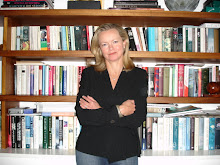Another day, more harrowing pictures from China & indeed, from Burma, where the regime can try & prevent overseas aid from coming in but is having markedly less success at preventing photographic evidence of the extent of cyclone death and devastation getting out.
Last week, David Viggers, Reuters UK Chief Photographer, wrote the blog post below:
http://blogs.reuters.com/photo/2008/05/15/why-i-became-a-news-photographer/
The post was accompanied by a series of powerful images of the Chinese earthquake. The impact was immediate: a series of comments, initially branding the photographs offensive, and even berating the author for "boasting of his brilliance" - when people needed hands-on help. Fortunately, a raft of subsequent comments praised the images and vindicated Viggers.
Yet the cyber-storm highlighted a perennial problem - who decides which images are acceptable, why and how do they make these decisions? How can we both be sure & ensure that vital images such as those currently coming out of Burma and China are both published and circulated?
Questions of propriety and prurience have become decidedly blurred in the multi-media 21st century of the ubiquitous image. Things have become far less clear cut since 1991, when Ken Jarecke's gruesome carbonized bust of an incinerated Iraqi combatant polarised picture editors across the globe. The image managed to escape the US military censor but was immediately pulled when it hit the AP wire Stateside. Nevertheless, several papers, among them the Observer in London chose to run with the shot.
http://news.bbc.co.uk/1/hi/world/middle_east/4528745.stm
The move succeeded in sparking a major debate: should editors protect their readers from the sight of such horrors, particularly when they might expect to be enjoying a leisurely weekend breakfast? Or was the image itself simply too important to spike, or to hide downpage on the foreign pages inside?
In Jarecke's case, the image, though indubitably upsetting, ultimately proved its intrinsic worth by demolishing, once and for all, Washington's line that the Gulf War to date had been 'clean bloodless and surgical' with an absolute minimum of Iraqi casualties.
For more, equally important, images from China, follow the link below:
http://www.reuters.com/news/pictures/articleslideshow?articleId=USSP23973420080515&channelName=topNews#a=15
skip to main |
skip to sidebar




from the frontline of photo-journalism & fine art
"Nonstop imagery is our surround, but when it comes to remembering, the photograph has the deeper bite....
In an era of information overload, the photograph..is like a quotation, or a maxim or proverb."
(Susan Sontag: Regarding the Pain of Others 2003)
In an era of information overload, the photograph..is like a quotation, or a maxim or proverb."
(Susan Sontag: Regarding the Pain of Others 2003)


@deejackson on Twitter

Queen & Country by Steve McQueen
The image above shows a detail from 'Queen & Country' by Iraq War Artist Steve McQueen. Find out more below & sign the petition for Royal Mail to issue the stamps in tribute to the fallen servicemen & women the project commemorates.
http://www.artfund.org/queenandcountry/Queen_and_Country.html
http://www.artfund.org/queenandcountry/Queen_and_Country.html

About Me
Dominique Jackson is a freelance writer & translator with more than 20 years’ experience of the Fourth Estate. She studied Modern & Medieval Languages at Magdalen College, Oxford and trained at Reuters News Agency after graduating.
She worked initially as a Foreign Correspondent, reporting from Latin America, South East Asia and Western Europe, and latterly, as a writer and editor on London’s Fleet Street. She is currently a columnist and blogger for the Mail Online RightMinds Debate project. Read her most recent articles here:
Dominique's work has also appeared in publications as diverse as the Guardian, the Spectator, the Financial Times, Marie Claire, Avenue Magazine, the Times Educational Supplement, the Volkskrant & the South China Morning Post.
My linguistic & editorial consultancy website can be found here: http://babelatbedlam.co.uk/
My latest project - raising awareness of Lewy Body Dementia and of elder and vulnerable adult abuse can be found here: http://ahappierending.blogspot.com/
My linguistic & editorial consultancy website can be found here: http://babelatbedlam.co.uk/
My latest project - raising awareness of Lewy Body Dementia and of elder and vulnerable adult abuse can be found here: http://ahappierending.blogspot.com/
